Reading Time: 15 mins

“The murals of Ajanta are now recognised as some of the greatest art produced by humankind in any century, as well as the finest picture gallery to survive from any ancient civilisation.” – mentions famous Scottish historian, writer and critic, William Dalrymple in one of his articles - The Ajanta cave murals: 'nothing less than the birth of Indian art'.
Located in the Maharashtra state in India, Ajanta is a series of mountain caves in the Sahyadri range of Western Ghats. They are positioned in a 76m high, horseshoe-shaped ridge overlooking the Waghora River. The caves form the largest surviving collection of wall paintings and rock-cut sculptures of ancient Indian art. It has been a UNESCO World Heritage site since 1983 and according to UNESCO, these are “masterpieces of Buddhist religious art that influenced the Indian art that followed”. There are 30 caves numbered 1 to 29 (There is a cave numbered 15A, because it was discovered later). 27 is partially collapsed, 28 & 29 are unfinished and located higher up the cliff face. These are also inaccessible now.
ANTIQUITY
These caves were hewed between c. 2nd century BCE to 500 CE i.e. in a huge time span of ~ 700 years. Most historians agree that the caves were built in 2 phases.
Although the exact date is unknown, palaeographic evidence suggests that first-phase hewing of the caves started somewhere between the 2nd & 1st century BCE with patronage from Satvahana Dynasty (c. 1st century BCE -2nd century CE). This means the caves were hewed shortly after the collapse of great Mauryan empire and these are roughly contemporary with the Buddhist stupas and gateways at Sanchi and Bharhut. Caves 8, 9, 10, 12, 13, 15A were hewed during the first phase. These belong to the Hinayana phase of Buddhism.
The remaining caves were hewed in the second phase, between 5th and 6th century CE largely under the patronage of the Vakataka dynasty (c. 250 CE to 500 CE), who were contemporaries of the Gupta emperors. These belong to the Mahayana phase of Buddhism. Dalrymple writes about the second phase: “This was at the height of India's golden age, when in the Gangetic plain, the Gupta dynasty was filling their capital of Kannauj with some of the greatest masterpieces of Indian sculpture, and when Kalidasa was writing his great play, The Cloud-Messenger (Meghdoot or Meghadutam).”

SHORT HISTORY OF THE PATRON DYNASTIES
SATVAHANA DYNASTY (C. 1ST CENTURY BCE - 2ND CENTURY CE) / FIRST-PHASE CONSTRUCTION: Satvahana dynasty is believed to be the first Deccan dynasty to build an empire in the southern India. According to Puranic evidence the family originated from Andhra tribe. There is some dispute on whether their ascendancy can be dated to 1st century or 3rd century BCE. Simuka is believed to be the founder of the Kingdom. Gautamiputra Satkarni (c. 106–130 CE) was the greatest ruler and the Satvahana power revived during his reign. Satkarni’s son Vashisthiputra Pulumavi (c. 130–159 CE) was also a famous ruler. The Indo-Roman trade reached its peak in Satvahana period. Satvahanas, however, were constantly on war with Kshatrapas, which was one of the key reasons for their deterioration. Shri Yajna (c. 174–203 CE) was the last important figure in the dynasty and after him fragmentation of the empire started.
The connection between Satvahana rulers and Ajanta can be securely concluded, however, the availability of information on the same is limited. It was probably during the reign of Satkarni, Pulumavi or somebody else who ruled in the century, when the first-phase hewing of Ajanta started. In Cave 10, we can find a Sanskrit inscription in Brahmi script dated 2nd - 1st century BCE, which was translated by Walter Spink as “The facade is the gift of Vashisthiputra Katahadi”.
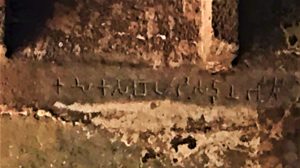
The inscription at Cave 10, translated as “The facade is the gift of Vashisthiputra Katahadi”. It is the oldest inscription in Ajanta dating back to 2nd - 1st century BCE. (PC - Ms Sarah Welch, Own work, CC BY-SA 4.0, source: commons.wikimedia.org)
IN-BETWEEN DORMANT PHASE: According to Spink, once the Satavahana period caves were made, the site was dormant for a considerable period of c. 500 years until the mid-5th century. However, as per Faxian (Fa Hien), although the construction of the caves had stopped, the existing caves were in use during the period and Buddhist pilgrims used to visit.
“The Ajanta Caves were hewed in 2 phases: the first phase by 2nd & 1st century BCE with patronage from Satvahana dynasty, the second phase between 5th & 6th century CE largely under the patronage of the Vakataka dynasty”
VAKATAKA DYNASTY (C. 250 CE TO 500 CE) / SECOND-PHASE CONSTRUCTION: After fragmentation of Satvahana, the eastern side of the region passed on to the Iksvakus followed by Pallavas. The western Deccan experienced the emergence of new local powers - the Cutus, the Abhiras, the Kurus etc. In the Berar region the Vakatakas emerged as a formidable power in the mid-3rd to early 4th century. The Vakataka dynasty was a Brahmin dynasty. Little is known about Vindhyashakti (c. 250 – 270 CE), the founder. Territorial expansion began in the reign of his son Pravarasena I.
INFLUENCE OF THE GUPTA EMPIRE (INDIA'S GOLDEN AGE): In the period of Prithvisena, the Vakatakas came into contact with the famous Gupta Empire, the contemporary dynasty ruling almost entire North India. Because of its territorial position, the Vakataka family was recognized by the Guptas as a useful ally against enemy, specially the Kshatrapas. The age-old common practice of strengthening alliance through marriage can be observed in Vakataka-Gupta case also. Prabhavati Gupta, the daughter of Chandra Gupta II, was married to Rudrasena II. Quite obviously, impact of the Guptas was significant in Vakataka polity and culture. After Rudrasena’s death, Prabhavati assumed power of Vakataka empire as regent because of minority of her sons. Vakataka influence, later, reached to even Central India. Majority of the historians agree that most of the work in Ajanta took place during Harisena over the very brief period from c. 460 to 480 CE. Vakatakas themselves were patrons of arts, architecture and literature plus there was obvious influence of the Guptas. Probably by now, you can relate the second-phase masterpieces of Ajanta to the zenith of Classical India or India's golden age.

WHAT HAPPENED AFTER THAT?
What happened to Ajanta after losing Royal patronage? A few years after the death of Harisena, the construction activity at the incomplete Ajanta Caves was abandoned. However, the caves appear to have been in use for a period of time. As already stated, Faxian (Fa Hien) reported about the caves in 7th century. After that no substantial reference of Ajanta has been found in any report. Most probably it lost contact with the outside world, but was known to the local people. Much later, in 16th century, Abu al-Fazl in Ain-i-Akbari mentioned about 24 (twenty-four) rock cut caves with remarkable idols. After that Ajanta, probably, was “lost” again for almost 3 centuries till its rediscovery in 1819. Unlike Ellora, Ajanta was not always in contact with the outside world. It had remained unidentified for considerable periods, probably because it is positioned at a height of 76m from the ground and covered with dense forest making it difficult to locate or access.
“In its history of 2000 years, Ajanta lost contact with the outside world several times until its final discovery in 1819”
REDISCOVERY OF THE CAVES
On 28 April 1819, John Smith, a British officer accidentally discovered (or rediscovered) Ajanta while hunting tigers in the surrounding forest. He spotted the mouth of Cave No. 10 and a local shepherd boy guided him to the cave door. The caves were well known by locals already. Captain Smith went to a nearby village and came back with the villagers to cut down the jungle making a way to Cave No. 10. While Smith should certainly be credited for discovery of the caves, he should be condemned for his next action. He knew that he had done something great that would make him famous. So, in order to keep a proof of his discovery he vandalised the wall by scratching his name and the date over the painting of a bodhisattva in Cave 10.
As expected, within a few decades, the caves became famous for their “exotic setting, impressive architecture, brilliant sculptures and above all exceptional & unique paintings.” A number of large projects to copy the paintings were made. In 1861, this became key project for the newly established Archaeological Survey of India (ASI).
During the British era, the Ajanta site was within the territory of the princely state of the Hyderabad. So, in the early 1920s, the Nizam of Hyderabad converted the site into a museum and built a road to bring tourists to the site with the objective of earning fees. This resulted in early mismanagement and accelerated the deterioration of the site.
However, post-independence, ASI and the state government of Maharashtra has managed the site far better. There is a modern Visitor Center with good parking facilities, public conveniences and ASI operated buses running at regular intervals from Visitor Center to the caves.

Top: Layout of the Caves as displayed at the site; Bottom: A model of Ajanta displayed inside Cave 16
“Ajanta has 30 caves: 5 are ‘Chaityas’ (Prayer or Worship Halls) and the rest are ‘Viharas’ (Monasteries)”
LAYOUT AND ARCHITECTURE
Following are relevant Structural / Architecture details:
- Position: Series of Rock-cut caves in the Sahyadri range of Western Ghats
- Rock type: Basalt
- Shape: Horseshoe-shaped ridge overlooking the Waghora River. Caves are arranged in series
- Thickness: The caves are carved into a 250-feet rock wall.
- Height: 76m from Ground Level
- Area: Approximately 8,242 ha
- Number of caves: 30
- Purpose: Buddhist Monastery Complex
- Structure of Individual caves: Primarily two types. (1) Chaitya (Prayer or Worship Hall): 5 numbers. Cave 9 and 10 (First-phase), Cave 19, 26 and 29 (Second-phase). Cave 29 is incomplete. (2) Vihara (Monastery): The rest are Viharas
A Chaitya is a hall with rectangular plan and high arched ceiling. The hall has a rectangular vacant space in the middle and two narrow side aisles separated by pillars. It also has a Stupa at the end. A Vihara is a hall with square plan and flat ceiling. The hall has aisles on all the sides. At the centre of the rear wall there is a shrine-room (Garva-griha), containing a large Buddha statue. There are smaller rooms along the side and rear walls. The viharas of the earlier period, however, do not have shrines.


SCULPTURES OF AJANTA
Sculptures are much younger than the Paintings of Ajanta and were mostly constructed during the second phase, approximately by the 4th century CE. On the initial sculptures, Buddha was not shown in human form, but through symbols. So, the Wheel, the Bodhi Tree, the Feet of Buddha etc. became the subjects of sculptures. Later, during Mahayana phase Buddha and Bodhisatva were added as subjects. Though the sculptures are famous for their grace, elegance and serenity, some experts consider these to be heavy in form and inferior to other contemporary sculptures. The sculptures were all plastered and painted, however, at present plasters can be seen only in a few sculptures with no trace of paints.

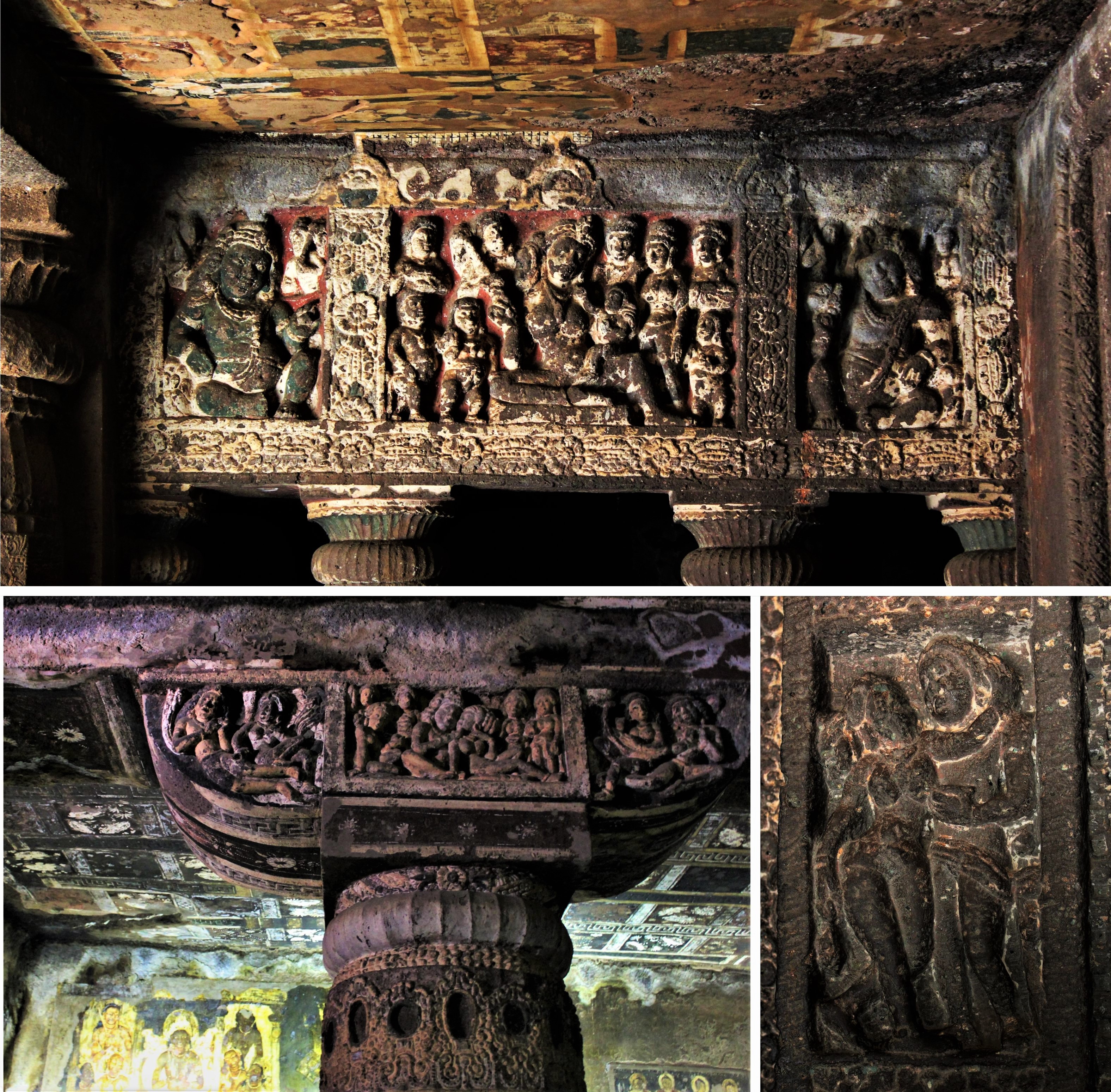

I am noting down a few famous sculptures below, which would help the first-time visitors-
- As already mentioned, the Garva-grihas at rear end of most of the viharas have a seated Buddha in preaching mode (Dharma chakra pravartana mudra).
- Sculptures of two Yaksha figures (Sankhanidhi and Padmanidhi), Hariti and Panchika (Cave 2).
- Various sculptures including the Elephants on the outside walls and Yaksha Figures including Bharvahaka Yakshas on the ceiling of Cave 16.
- Sculpture of Buddha offering begging bowl to his son Rahula and another sculpture of Nagaraja and his wife (Cave 19).
- Mahaparinirvana of Buddha on the left wall of Cave 26.
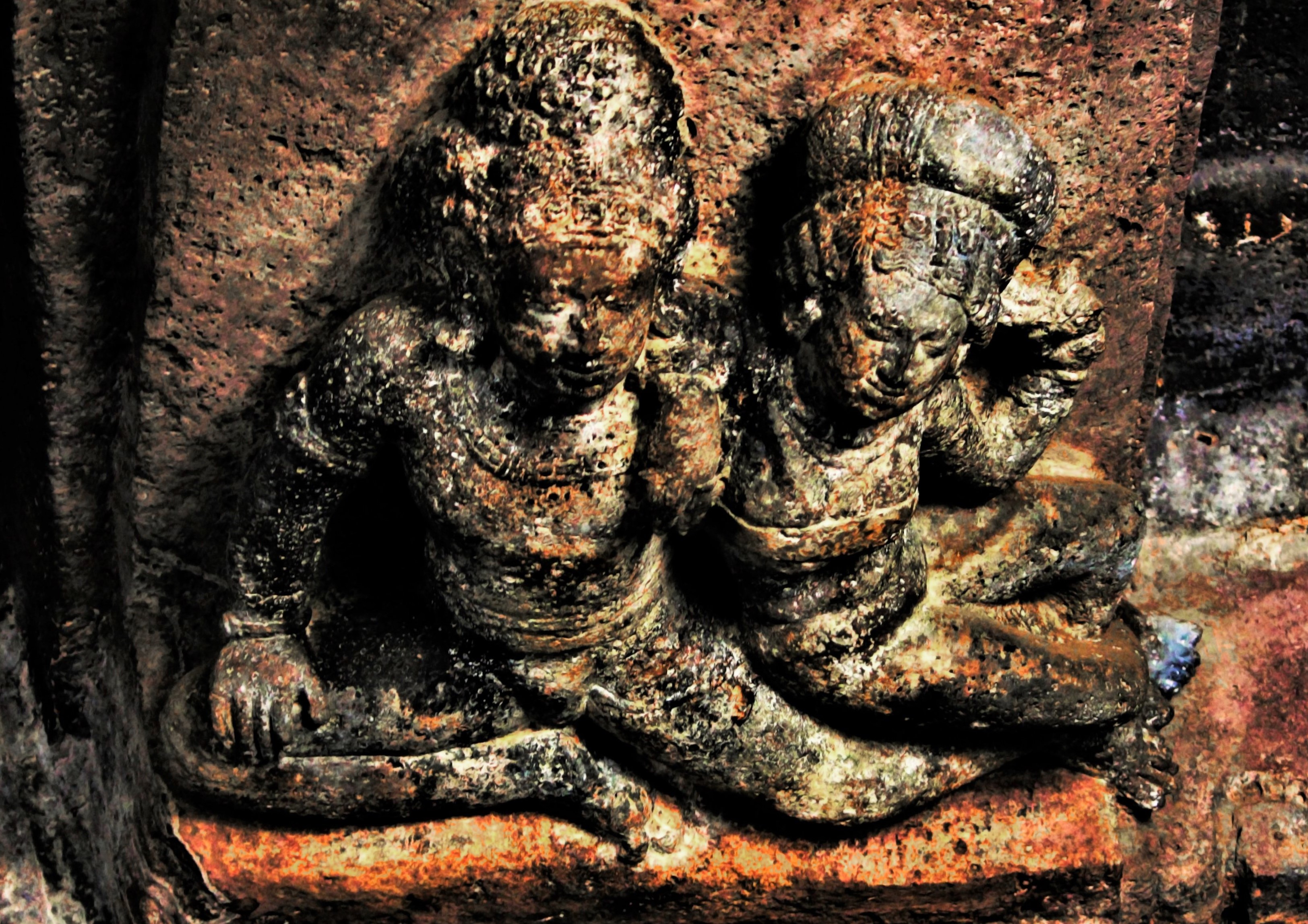

Various Yaksha Figures including Bharvahaka Yakshas. All the sculptures can be seen on the ceiling of Cave 16

Left: Sculpture of Nagaraja and his wife; Right: Sculpture of Buddha offering begging bowl to his son Rahula (Cave 19)

PAINTINGS OF AJANTA
Ajanta cave paintings occupy the pre-eminent position in the mural traditions of the World. Even though original lustres of the paintings are now faded, bold brush-strokes and swiftness of outlines represent a class of their own. In terms of Antiquity, again quoting Dalrymple, these are “the oldest paintings of Indian faces – with the exception of a few prehistorical pictograms of stick men and animals left by Palaeolithic hunters in the wilds of Madhya Pradesh (Bhimbetka). They are also the oldest Buddhist paintings in existence, dating from only 300 years after the death of the Buddha.”
It is believed that Buddhist monks used to spend a significant amount of time at the Ajanta caves during the monsoons when they were refrained from travelling. The monks put their creativity and time to use by painting the walls of the caves.

Padmapani (Top) and Vajrapani (Bottom). The famous paintings of the two Bodhisattvas can be seen on the rear walls on either side of the main Buddha shrine in Cave 1
NATURE AND SUBJECT OF PAINTING
The paintings are mostly semi-abstract in nature representing a bounty of beliefs, morals, emotions and intellectual settings. Jataka tales, the chronicles related to different incarnations (Avatars) of Buddha, form one of the key subjects of the paintings. Originally written in Pali language and later translated in different languages around the world, the fables of ‘Jataka’ were intended to impart self-sacrifice, morality, honesty and other values to people. Around 550 in number, Jataka Tales are an important part of Buddhist literature. Their extensive adoption in Paintings of Ajanta demonstrates a wide acceptance of the tales even in 2nd Century BCE. As Buddhism evolved from earlier Hinayana to Mahayana faith, the depictions transformed. Thus, in the murals of the first phase Caves 9 and 10 depictions were symbolical - the Bodhi tree, paduka (wooden footwear), wheel etc. In the later phase, murals embodied celestial beings including Kinnara, Gandharva etc.
“The world-famous murals of Ajanta were painted using a technique quite similar to European Fresco technique. The subjects were mostly semi-abstract in nature”
PAINTING TECHNIQUE AND MATERIALS USED
The interior surfaces of the caves were plastered prior to any painting work. Typically, the plasters were of 3 layers, a first layer of earth, sand, vegetable fibres and other organic fibrous materials, a second layer of mud mixed with pulverised rock powder or sand and fine vegetable fibre and finally a third coat of lime wash. Paintings were carried out on this surface applying various pigments, which were of mineral origin: Terra verda or glauconite (green), lapis lazuli (blue), kaolin, lime etc. Black colour, however, was obtained from kohl. The painting techniques are to some extent similar to European Fresco technique - the primary difference is that the first layer of plaster was dry when it was painted.
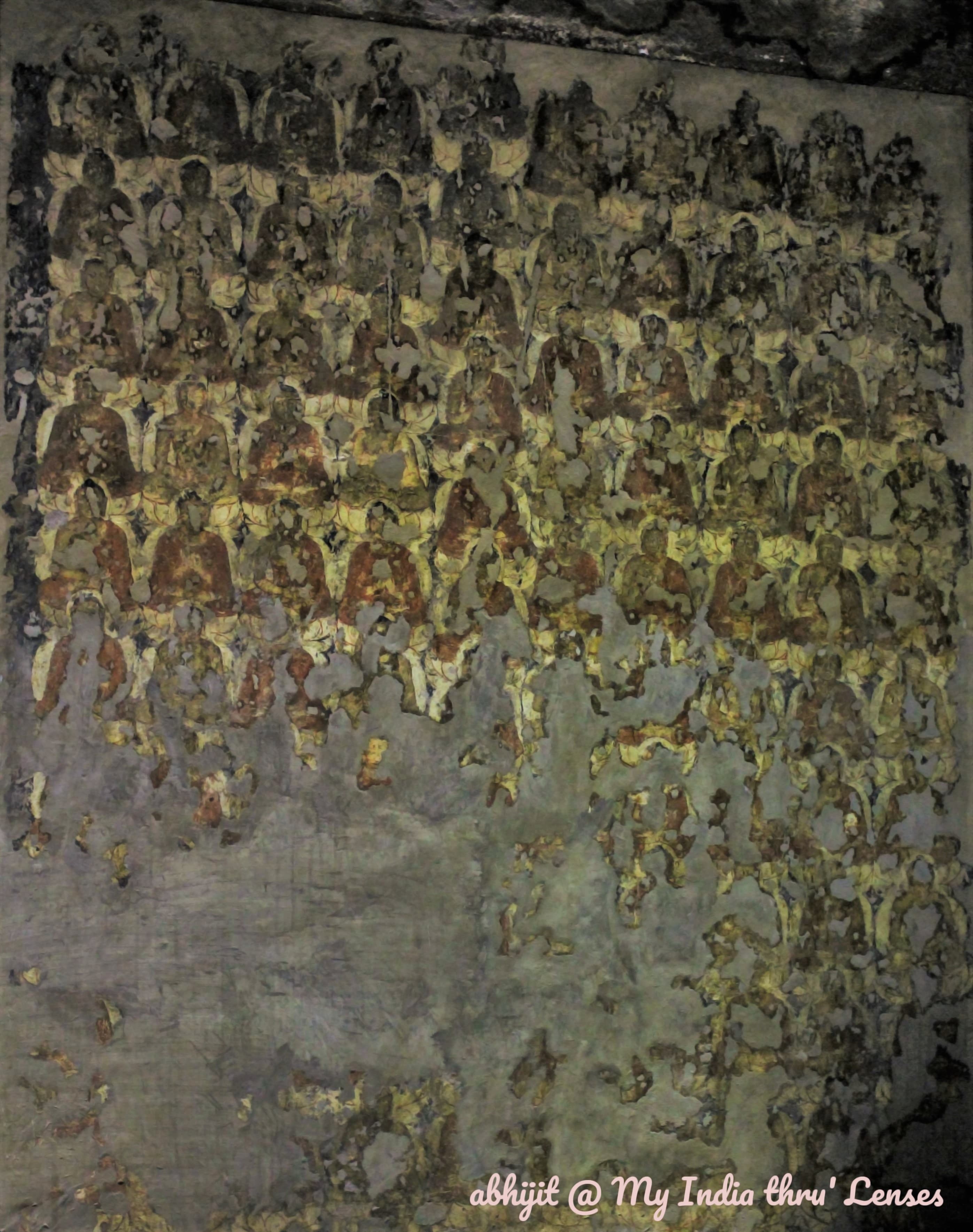
FAMOUS PAINTINGS
- The world-famous paintings of the two Bodhisattvas Padmapani and Vajrapani in Cave 1. The paintings, probably everybody has seen in History books. Cave 1 also contains 20 painted pillars. Above the pillars are reliefs depicting Jataka tales. On the left of the main shrine, there is also the painting of Bodhisattva Avalokitesvara. The ceiling has beautiful designs and motifs.
- Cave 2 ceilings and walls have paintings depicting Jataka tales. One of the walls shows a large painting of ‘Thousand Buddhas’.
- In Cave 4 the walls of the antechambers are decorated with paintings of 6 huge standing Buddhas, two of them are unfinished.
- The depiction of Miracle of Sravasti and Temptation of Mara are the important paintings in the lower storey of the double-storied Cave 6.
- Cave 10 consists paintings of two periods. The early period (2nd century BCE) paintings are Jataka tales. The later period (4th - 6th century CE) paintings contain Buddha figures in various poses mainly over the pillars.
- Cave 16: The Portrait of the Dying Princess is one of the famous paintings of Ajanta. Sundari, wife of Buddha's half-brother Nanda, is said to have expired at the news that her husband was renouncing the material life, in order to become a monk. There is also the Painting depicting story of Sujata offering a bowl of kheer to Siddhartha (It was his first food after Siddhartha became the Buddha). There are also some Jataka stories in this cave. The Hasti Jataka is the story of Bodhisattva as an elephant. He gave up his life by throwing down himself to provide food to those affected by hunger. In Maha-ummang Jataka, Bodhisattva settled a dispute between the two mothers claim for the same child. Some events of the life of the Buddha and Miracle of Sravasti are other paintings at this cave.
- Cave 17 houses some notable paintings of the Vakataka age that includes Vessantara Jataka, a gigantic wheel representing the Wheel of Life, the Flying apsara, the story of subjugation of Nalagiri, the paintings depicting Coming of Sinhala and Consecration of King Sinhala.



PRESENT CONDITION OF THE PAINTINGS
Being exposed to several factors like humidity, ultra-violet radiation, noise levels, seepage of water through weathered rocks, carbon dioxide from the exhalation of humans, for more than 2000 years, most of the paintings are deteriorated beyond repair. ASI and UNESCO have imposed very strict restrictions to the visitors in order to preserve these, such as restricting the number of visitors at a time, banning camera flashes and tripods etc.



THE MUST-SEE CAVES
If I have confused you with too much details of the sculptures and paintings, here is something that will help you. I am listing the caves that, according to me, are must-see: 1, 2, 4, 6, 9, 10, 16, 17, 18, 19 & 26. You may skip the others, if you don’t have enough time or energy. However, we didn’t even think of skipping any. It took us almost 5 hours to complete all the caves.
OUR FULL DAY TRIP IN SHORT
We visited Ajanta as a day-trip from Aurangabad by hiring a cab on the third day of our tour. Please read my first blog Part A - Into the Mysterious Caves of Ajanta & Ellora, where I have shared our full 6-day itinerary. We started from our hotel in Aurangabad by 8.30 am and reached Ajanta Visitor Centre at 11.30 am. From the visitor centre you have government buses (One-way Ticket price INR 20 per head) at regular intervals to take you to the caves. Public vehicles are not allowed beyond the Visitor Centre. The Visitor Centre is equipped with parking facilities and other public conveniences. There is also a shopping plaza with a number of Handicraft shops. We parked shopping for the evening and boarded a bus immediately to reach the caves.
At the foot of the caves, you have to buy entry tickets from the counter. We had booked our tickets online (see details below) and that saved some of our time. We refreshed ourselves a bit and then proceeded towards the caves by 12 noon. We completed all the caves by 5 pm. No lunch in between! Believe me or not, lunch never came into our mind during these fascinating 5 hours.

WHERE TO EAT: After finishing all the caves, we entered the MTDC restaurant just at the foot of the caves. While going, I had already noticed that the restaurant offers beer. We ordered for a non-vegetarian thali along with Carlsberg. Mesmerizing tour of the caves followed by chilled beer, simply awesome! The restaurant serves good food and isn’t very costly.
WHERE TO SHOP: Finishing lunch, we took the bus to return to the Ajanta Visitor Centre, where our vehicle was parked. It was 5.30 pm. We thought of doing some shopping from the Shopping Plaza. The Shopping Plaza is famous for variety of stones, jewelleries made of semi-precious stones and decorative pieces. The shops have good collection, but do not buy anything without bargain. We purchased one showpiece finally at INR 1200 that was initially told as INR 2800. Shops closer to the parking lot i.e. farthest away from the bus terminal are cheaper than the ones closer to the terminal.
We completed shopping and headed back towards Aurangabad by 6.00 pm. By 9.30 pm we returned to our Hotel in Aurangabad.
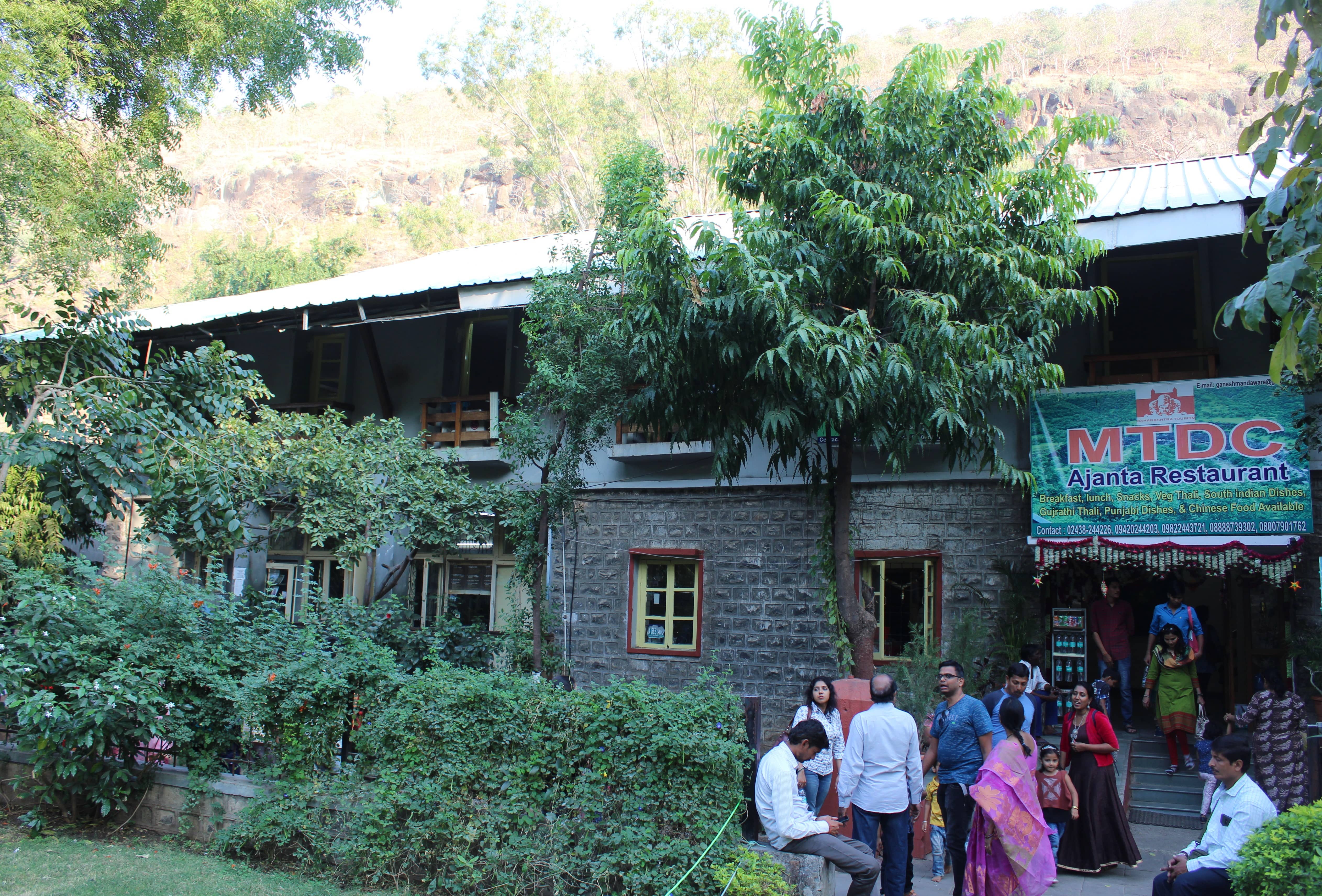
At least 5-6 hours are necessary to see all the caves. In case of time constraint, the caves 1, 2, 4, 6, 9, 10, 16, 17, 18, 19 & 26 are must-see.
IMPORTANT INFORMATION FOR TOURISTS
Cave Timings: 9.00 am to 5.30 pm (IST) / 6 days a week. Closed on Monday
Entry Ticket Charges
- Indians (below 15 years): FREE
- Indians (above 15 years): INR 40/- per head
- Foreigners (SAARC Citizens): INR 40/- per head
- Foreigners (other than SAARC): INR 600/- per head
- Camera Charges: INR 25/- (Use of Flash Prohibited)
(It is recommended that you confirm Timings and Charges from the website before going, because these keep on changing)
Official website: www.ajantacaves.com – The Information Portal. Click here.
Online Ticket Booking: ASI has now started online booking of entry tickets. It can be done through Yatra or BookMyShow Mobile App or Website. This is a good option to avoid rush at the ticket counter during the seasons. However, these are non-refundable.
- Yatra: Book Tickets for Ajanta
- BookMyShow: Online Tickets for Ajanta
DO’S & DON’TS
- Photography is allowed inside the caves, but use of flash is prohibited, especially in the caves that have paintings. Flash light may harm the age-old paintings. No worries, the authorities have permanently lit up the caves with enough tiny LED lamps of various colours for you to observe and capture the magnificent art-works.
- You will find hawkers selling things at the caves, but avoid them. Shopping Plaza is better.
- The Shopping Plaza is excellent, but do bargain. Otherwise, you will be robbed.
- We visited Ajanta as day-trip from Aurangabad. One-night stay in Ajanta is also a good option. You can book rooms at Ajanta Tourist Resort or Ajanta T Junction (MTDC Guest House). There are certain other options as well.
REFERENCES
- Ajanta, History and Development, Walter M. Spink
- The Ajanta cave murals: 'nothing less than the birth of Indian art', William Dalrymple, 15 Aug 2014, The Guardian
- Unseen Ajanta, William Dalrymple, 24 Nov 2014, Outlook India
- The Ajanta Caves, Dola RC, 09 Dec 2015, Ancient History Encyclopaedia
- Encyclopaedia Britannica (https://www.britannica.com/)
- Wikipedia (https://en.wikipedia.org/)
Photographs, unless otherwise credited, are self captured.
Sure.
Hi Abhijit, just read the part 2 of ur blog. Amazing research. As I love history, liked the fact that you researched the history of the caves so well and provided accurate facts. As a blogger, this work will provide me direction. Keep up the good work.
Hi, Thanks for your message. I am new in the blogging world and your message is encouraging for me. Please be in touch.